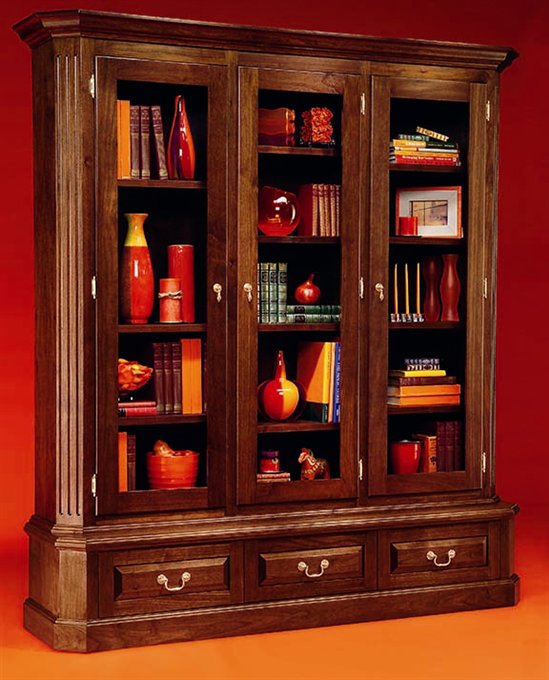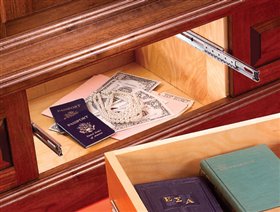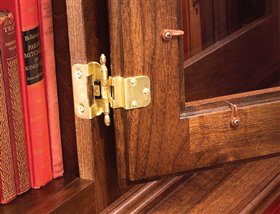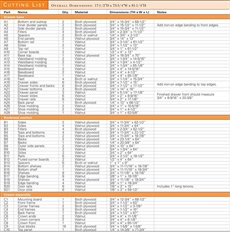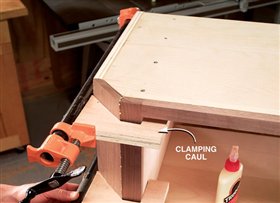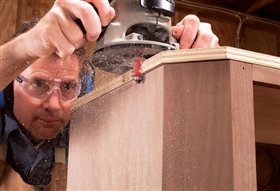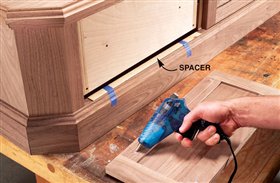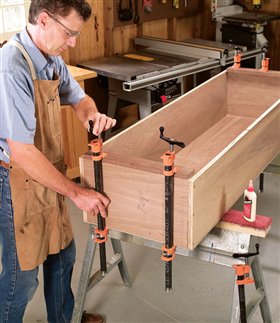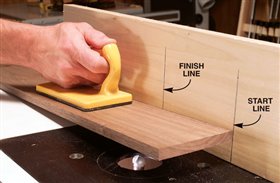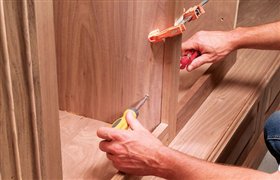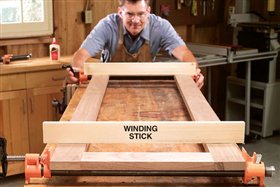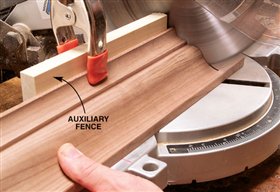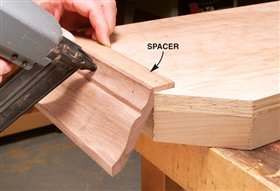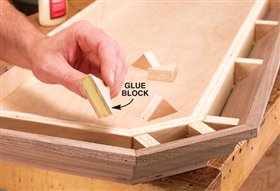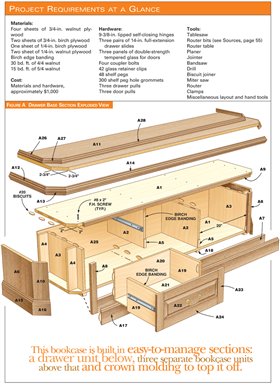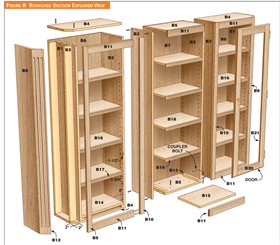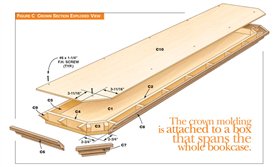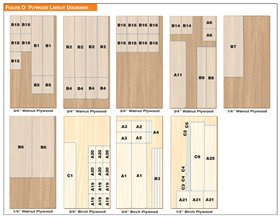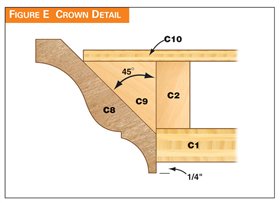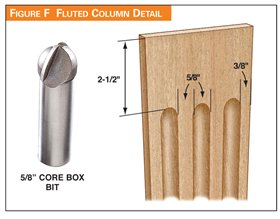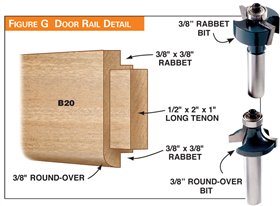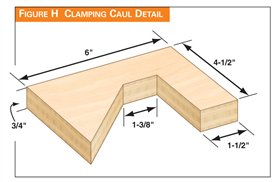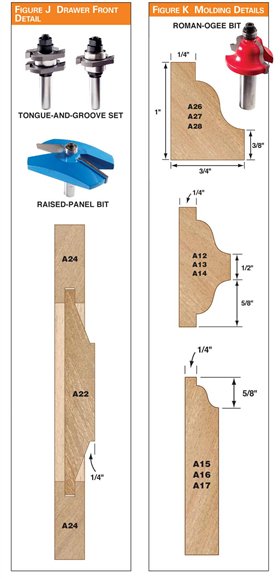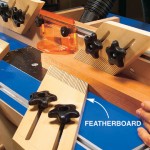We may receive a commission when you use our affiliate links. However, this does not impact our recommendations.
Grand Walnut Bookcase
Rich Walnut, elegant details and secret storage in a design that’s fast and straight forward to build
by Randy Johnson
| Sometimes a new piece of furniture conjures up images from a distant time and place. This bookcase, I imagine, would fit right into an early 20th-century lawyer’s office, filled with leather-bound volumes and smelling of cigars. Rich walnut and generous moldings give it a luxurious feel, and hidden compartments are perfect for top-secret documents. The glass doors are as practical today for keeping dust off your books as they were 100 years ago. I’ve designed this bookcase for a thoroughly modern cabinetmaker, however. Its plywood cases are built with biscuits, the drawers use full-extension ball-bearing slides and the lipped doors are hung with easy-to-install wrap-around hinges. To make this large project more manageable, I built it in sections: a drawer unit below, three separate bookcase units above and a crown molding unit on top. The modular design also makes it easy to move it around your shop and into your house.A big project like this does require a bit of experience. You’ll need to know how to use a biscuit joiner, be well-versed in using a router and router table and know how to install drawer slides. The only advanced technique you may need to know is how to make and install the custom crown molding. If you make the bookcase in oak or birch, you could buy commercial crown molding, but if you choose walnut or cherry, you’ll probably want to make the molding yourself. One approach is covered in “Crown Molding on the Tablesaw” article. |
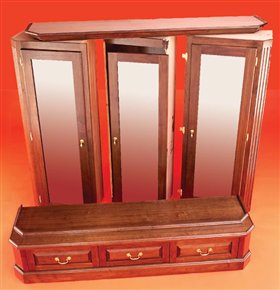
The modular design of this cabinet makes it easy to build and move.
Secret storage below the drawers provides a hiding place for valuables.
Lipped doors are easy to fit and hang and will even hide gaps caused by the doors being slightly warped or out of square. |
Start with the Drawer Base1. Assemble the drawer base with biscuits, screws and glue. (Fig. A, below; Fig. D, below). The bottom and subtop (A1) are identical. Set the inner divider panels (A2) flush with the back edge of the subtop and bottom, leaving a 1/4 in. space at the front. This space provides some clearance behind the drawer fronts. The side divider panels (A3) are set flush at the front and back of the subtop and bottom. After these parts are assembled, glue and clamp the fillers (A4) into place and add the spacer blocks (A5) to the front bottom edges of the vertical dividers (A2). 2. Add the walnut end panels (A6) to the drawer base (Photo 1). The end panels should extend 1/4 in. behind the base bottom and subtop. This creates a lip for the back (A25) to fit into. 3. Join the wide bottom rail (A7) to the two side stiles (A8) with biscuits and attach this three-sided assembly to the plywood drawer base. Next, glue the narrow top rail (A9) directly to the front top edge of the drawer base between the side stiles (A8). Don’t worry if the joint between these parts isn’t perfect; a molding will cover it. 4. Attach the angled corner boards (A10) with cauls and clamps (Photo 2; Fig. H, below). I used my jointer to create the beveled edges on these corner boards, but a fine-tooth blade in your tablesaw or a chamfering bit in a router table will also work. Using the dimensions from the Cutting List, page 55, will create corner boards that are slightly wider than needed so they will have a small overhang on each side when installed. The overhang makes fitting easier and is easily sanded off after the glue dries. Starting oversize is better than being undersize, which would expose the core of the plywood end panels (A6). 5. Add the base top (A11) to the drawer base. Leave it slightly oversize at the front and the ends and flush-trim it to match the base below (Photo 3). The back edge of the top should be flush with the back edges of the end panels (A6). 6. Use a roman ogee router bit (see Sources, below) in your router table to create the edge molding (A12, A13, A14) and the baseboard molding (A15, A16, A17) (Fig. K, below, for details on these moldings) 7. Attach the edge molding and baseboard molding with glue and a few brad nails. The miters on the baseboard use biscuits for alignment on the wide mitered joints. Note that the baseboard overhangs the bottom edge of the drawer base by 3/4 in. 8. Screw the feet (A18) to the bottom of the drawer base. 9. Next, build the drawer boxes (A19, A20, A21). I built the drawers out of birch plywood and joined them with biscuits. This is simple and fast, but you can use any method you choose. The drawer bottoms (A21) fit in a quarter inch deep dado. Install the drawers on full-extension drawer slides (see Sources, below). 10. Make the raised-panel drawer fronts (A22, A23, A24). I routed the raised panel so it stands proud of the drawer frame for a bolder look (Fig. J, below). 11. Screw the drawer front to the drawer boxes (Photo 4). 12. Screw on the back panel (A25).
Build the Three Bookcase Cabinets13. Cut the plywood tops, bottoms, sides and fillers (B1 through B5) for the three bookcase units and assemble them with biscuits, glue and screws (Fig. B, above). Screw on the backs (B6, B7). 14. Add the outer side panels (B8) to the two outer cases. 15. Assemble face-frame parts (B9, B10, B11) with dowels or biscuits. Make sure the frames are square. 16. Glue the face frames to the two outer cases. 17. Attach the bottom and top rails (B11) to the center case (Photo 5). The center case is 1/8-in. narrower than the space it fills. This ensures that the ends of the rails (B11) will pull up tight to the stiles (B10) on the side cases. 18. Rout the flutes in the angled corner boards (B12, Fig. F, below; Photo 6) with a core box bit in your router table. Marks on the fence represent the start and end points of the flutes. Carefully lower the board onto the core box bit to start the flute and tip the board up off the bit when it reaches the second mark. The only tricky thing about this fluting is that walnut tends to burn easily. Three precautions help you avoid burn: Use a new or freshly sharpened bit. Make the cut in several passes, with the final pass the lightest. Keep the work moving, because stopping creates extra friction, which can lead to burning. 19. Attach the fluted corner boards to the bookcases with the same clamping cauls that you used on the drawer base (Photo 2). 20. Stand the three cases on the drawer base. 21. Clamp the bookcases together, making sure the rails on the center bookcase line up flush with the face-frame stiles on the side bookcases. With everything aligned, drill the holes for the coupler bolts (see Sources, below) and install them (Photo 7). 22. Next, make sure the back of the bookcases and the back edge of the drawer base are lined up, with the bookcases centered left and right on the drawer base. With everything lined up, screw the bookcases to the drawer base using four 2-in. screws through the bottom of each bookcase section. 23. Add the shoe molding (A26, A27, A28, Fig. K, below) around the bottom of the bookcase units. Glue and brad-nail this molding to the top (A11) of the base, not to the bookcases. 24. Screw the bottom spacers (B13) to the bottom of the bookcase and drop in the bottom shelves (B14, B15). The bottom spacers are shorter than the depth of the shelf space so you can push down on the back of the bottom shelves and tip up their front edges for removal. This even creates a little secret storage space. 25. Use a template and a self-centering bit (see Sources, below) to drill the holes for the shelf pegs and hole grommets (see Tips for Installing Shelf Supports). 26. Cut the shelves and glue on the edge banding (B16 through B19). 27. Make the doors (B20, B21). Mortise-and-tenon joinery provides strength and helps the doors glue up flat, but you should still use winding sticks to check the doors for flatness (Photo 8). 28. Use a round-over router bit to shape the outside corner of the door and a rabbeting bit to create the lip and the rabbet for the glass (Fig. G, below). 29. Hang the doors with 3/8-in. lipped hinges (see Sources). 30. Measure the opening for the glass and allow 1/16-in. clearance all around. Install the glass using glass clips (see Sources).
Add the CrownYou’re not going to find walnut crown molding at your local home center or lumberyard, and buying such a small quantity from a custom molding shop is likely to be an expensive option. So here’s a chance to get creative with your tablesaw (see “Crown Molding on the Tablesaw”). Another method for making it yourself is with a molding machine, such as the Woodmaster (see Sources). 31. Start building the crown section (Fig C, below) by cutting the mounting board (C1) slightly oversize on the front and ends, screwing it to the top of the bookcases and flush-trimming the front and the ends the same way you did with the drawer base top (A11; Photo 3). 32. Remove the mounting board from the top of the bookcase and attach the edge boards (C2 through C5). 33. Next, cut the crown molding to size (Photo 9). A miter saw set at 22-1/2 degrees is the perfect tool for this. If you use your tablesaw, you will need to set your blade to 15-3/4 degrees and your miter gauge to 73-3/4 degrees. Make sure to run some test pieces to check the settings. (For some great information on cutting compound angles with a miter saw, go to “www.Dewalt/miters.com”.) 34. Attach the crown molding (C6, C7, C8) to the mounting board with glue and brads (Photo 10, Fig. E). 35. Add glue blocks (C9) behind the crown molding for added strength (Photo 11). 36. Screw the crown assembly to the top of the bookcases and add the top panel (C10). 37. Add the door and drawer pulls (see Sources, right). 38. With the building completed, you can now disassemble the bookcase sections, do a final sanding and apply a stain and topcoat finish. I choose a dark stain (see Sources) and then applied a satin lacquer topcoat using an HVLP spray gun.
Sources(Note: This information may have changed since the story’s original publication date.) Woodworkers Supply, woodworker.com, 800- 645-9292, 3-1/2-in. brass swan neck bail drawer pull, #940480, $5.70 ea.; 2-1/4-in. brass drop door pull, #115892, $8 ea. Glass Source, theglasssource.com, 800-588-7435, Three panels of double-strength tempered glass, approx. 13-5/8 in. x 54-1/8 in., $25 ea. Woodworkers Hardware, wwhardware.com, 800-383-0130, 14-in. full-extension drawer slides, #KV4100P14, $11.13 a pair; Connecting screws for coupler bolts, #H267.00.720, $2.25 for 20; Sleeves for coupler bolts, #H267.00.913, $4.40 for 20; 5-mm spoon shelf supports, #HB214, $2.20 for 20; Connecting screws for coupler bolts, #H267.00.720, $2.25 for 20; Sleeves for coupler bolts, #H267.00.913, $4.40 for 20. 5-mm spoon shelf supports, #HB214, $2.20 for 20; Grommets for 5-mm shelf supports, #KV0326, $2.80 for 20; Glass retainer clips, brown, 5/16-in. tab, #HB21114, $3.80 for 20; 3/8-in. inset brass hinge, #A07565T1077, $4.43 a pair. Rockler, rockler.com, 800-279-4441, 7/32-in. self-centering bit (for shelf-support grommets), #39342, $20. MLCS, mlcswoodworking.com, 800-533-9298, 5/8-in.-dia. core box bit, #6420, $14 ea.; 3/8-in. rabbeting bit, #7691, $15 ea.; 3/8-in.-rad. round-over bit, #8654, $15.50 ea.; 1/4-in.-rad. roman-ogee bit, #8661, $21 ea. Bosch, boschtools.com, 877-267-2499, Raised-panel router bit, #85639M, $100 ea. Freud, freudtools.com, 800-334-4107, Roman ogee bit, #38-106, $27 ea. 3/8-in. rabbeting bit, #32-102, $21 ea.; 3/8-in. round-over bit, #34-124, $22 ea.; 1/2-in.-dia. flush-trim bit, #42-110, $14 ea. Amana, amanatool.com, 800-445-0077, Tongue-and-groove set (includes one shank arbor, two cutters and two bearings), #55400, $54 ea.; 5/8-in. core box bit, #45916, $28 ea. Minwax, minwax.com , 800-523-9299, Jacobean Wood Finish stain, #2750, $8 per quart. Woodmaster, woodmastertools.com, 800-821-6651, Planer molder machines, $1,400 to $3,400.
Cutting List
This story originally appeared in American Woodworker November 2005, issue #118.
|
 1. Both the lower drawer unit and the upper bookcase units have hollow ends. They act as torsion boxes, strengthening the units.
2. Gluing the angled corners can be tricky, but it’s easy with a pair of plywood cauls. They hook around the front stile to prevent slipping and apply pressure to the corner’s face.
3. Trim the base top of the drawer unit even with the case. A perfect fit is important, and it’s much easier to achieve with a flush-trim router bit than by measuring and sawing.
4. Temporarily attach the drawer front with a few dabs of hot-melt glue. Open the drawer and drive in the screws that will permanently hold the front. When you’re ready for finishing, remove the front and scrape off the hot glue.
5. The bookcase section is composed of three independent boxes, which make assembly a lot easier than handling one larger cabinet. The center unit, shown here, has bare plywood edges that will be covered by the side units’ stiles.
6. Flute the corner boards for the bookcases with a core box bit on your router table, tipping the board onto the router bit at the beginning and up at the end. Start and stop marks on the router fence provide the starting and stopping points of the flute.
7. Join the three bookcases with coupler bolts. Use a clamp to hold the cases together and double-check that the face-frame rails and stile line up flush at the top and bottom of the cases.
8. Assemble the doors. Check that they are flat by sighting down a pair of winding sticks. Add shims, if needed, under the clamps until the top edges of the winding sticks align with each other. After the doors are out of the clamps, to avoid warping, make sure to store them flat until you install them.
9. Cut the crown molding. Nesting the molding against the table and a tall auxiliary fence simplifies mitering, because it doesn’t require a compound miter setup.
10. Attach the crown molding to the mounting board with a brad nailer. Use a spacer to create a lip on the bottom side. This lip will overhang the top edge of the bookcase units and hide the joint.
11. Add triangular glue blocks behind the crown molding for added strength. This crown assembly is screwed to the top of the bookcase.
Fig. A: Drawer Base Section Exploded View
Fig. B: Bookcase Section Exploded View
Fig. C: Crown Section Exploded View
Fig. D: Plywood Layout Diagrams
Fig. E: Crown Detail
Fig. F: Fluted Column Detail
Fig. G: Door Rail Detail
Fig. H: Clamping Rail Detail
Fig. J & Fig. K: Drawer Front Detail & Molding Detail |
Here are some supplies and tools we find essential in our everyday work around the shop. We may receive a commission from sales referred by our links; however, we have carefully selected these products for their usefulness and quality.



